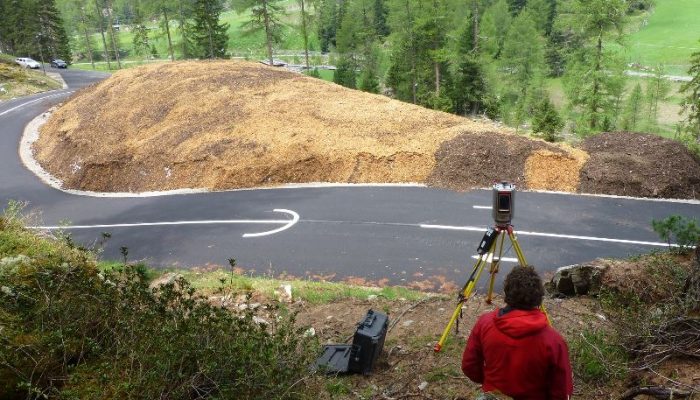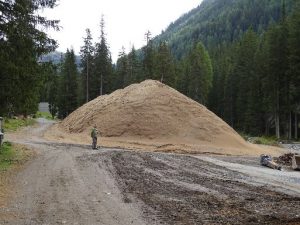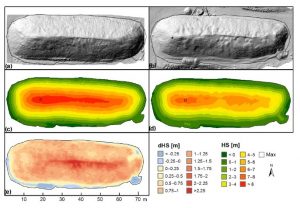
For roughly the last decade, some ski resorts and other winter sport facilities have been using a pretty unusual method to ensure white slopes in winter. It’s called snow farming. The practice involves collecting natural or artificially made snow towards the end of winter, then storing the frozen mass in bulk over the summer under a thick layer of sawdust, woodchips, mulch, or other insulating material.
Many winter sport destinations have adopted the practice. In preparation for the 2014 Winter Olympics, Sochi, Russia stockpiled about 800,000 cubic metres of human-made snow during the warmer season, enough snow to fill 320 Olympic-size swimming pools.
Despite the growing trend, there still is little research on snow farming techniques. Recently, a team of scientists from the Institute for Snow and Avalanche Research (SLF) and the CRYOS Laboratory at the École Polytechnique Fédérale in Switzerland examined the success of snow conservation practices and used models to estimate what factors influence covered snow. Their findings were published in the EGU’s open access journal The Cryosphere.
Why store snow for the winter?
The ski industry has been storing snow for many reasons. The practice is a way for winter sports facilities to accommodate training athletes, start ski seasons earlier, and guarantee snow for major sports events. Snow farming can also be seen as a way to adapt to Earth’s changing climate, according to the authors of the study. Indeed, research published last year in The Cryosphere, found that the Alps may lose as much as 70 percent of snow cover by the end of the century if global warming continues unchecked. Snow loss to this degree could severely threaten the $70 billion dollar (57 billion EUR) industry and the alpine communities that depend on ski tourism.
For some ski resorts, the effects of climate change are already visible. For example, in Davos, Switzerland, a popular venue of the International Ski Federation Cross-Country World Cup, winter temperatures have risen over the last century while snow depth in turn has steadily declined.
Snow heap study

The research team studied two snow heaps: one near Davos, Switzerland (pictured here) and another in South Tyrol. Credit: Grünewald et al.
To better understand snow conservation techniques, the research team studied two artificially made snow heaps: one sitting near Davos and another located in South Tyrol. Each pile contained approximately 7,000 cubic metres of snow, about enough ice and powder to build 13,000 1.8-metre tall snowmen. The piles were also each covered with a 40 cm thick layer of sawdust and chipped wood.
Throughout the 2015 spring and summer season, the researchers measured changes in snow volume and density, as well as recorded the two sites’ meteorological data, including air temperature, humidity, wind speed and wind direction. The research team also fed this data to SNOWPACK, a model that simulates snow pile evolution and helps determine what environmental processes likely impacted the snow.
Cool under heat
From their observations, the researchers found that the sawdust and chipped wood layering conserved more than 75 percent of the Davos snow volume and about two thirds of the snow in South Tyrol. Given the high proportion of remaining snow, the researchers conclude that snow farming appears to be an effective tool for preparing for winter.
According to the SNOWPACK model, while sunlight was the biggest source of snow melt, most of this solar radiation was absorbed by the layer of sawdust and wood chips. The simulations suggest that the snow’s covering layer took in the sun’s heat during the day, then released this energy at night, creating a cooling effect on the snow underneath. Even more, the model found that, when the thick layer was moist, the evaporating water cooled the snow as well. The researchers estimate that only nine percent of the sun’s energy melted the snow heaps. Without the insulating layer, the snow would have melted far more rapidly, receiving 12 times as much energy from the sun if uncovered, according to the study.

Images of the South Tyrol snow heap from (a) 19 May and (b) 28 October. The snow depth (HS) is featured in c & d and snow height change (dHS) is shown in e. Credit: Grünewald et al.
The researchers found that the thickness of the covering layer was an important factor for snow conservation. When the team modelled potential snow melt under a 20 cm thick cover, the insulating and cooling effects from the layer had greatly diminished.
The simulations also revealed that, while higher air temperatures and wind speed increased snow melt, this effect was not very significant, suggesting that subalpine areas could also benefit from snow farming practices.
In the face of changing climates and disappearing snow, snow farming may be one solution for keeping winters white and skiers happy.
References
Grünewald, T., Wolfsperger, F., and Lehning, M.: Snow farming: conserving snow over the summer season, The Cryosphere, 12, 385-400, https://doi.org/10.5194/tc-12-385-2018, 2018.
Marty, C., Schlögl, S., Bavay, M., and Lehning, M.: How much can we save? Impact of different emission scenarios on future snow cover in the Alps, The Cryosphere, 11, 517-529, https://doi.org/10.5194/tc-11-517-2017, 2017.




